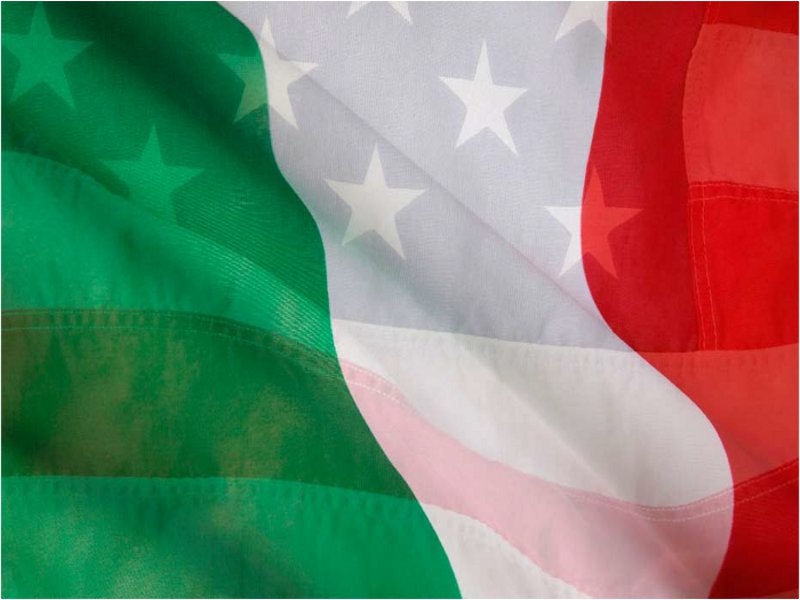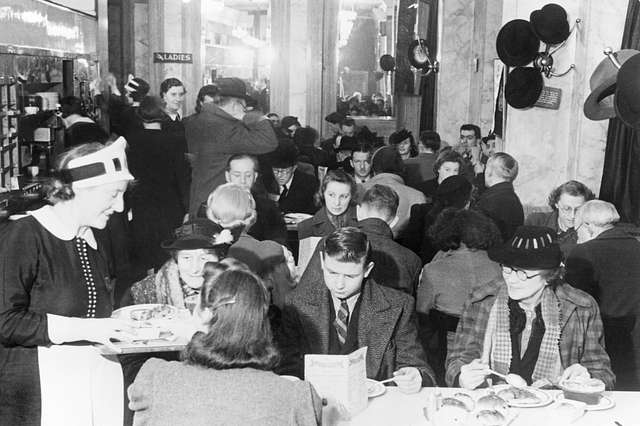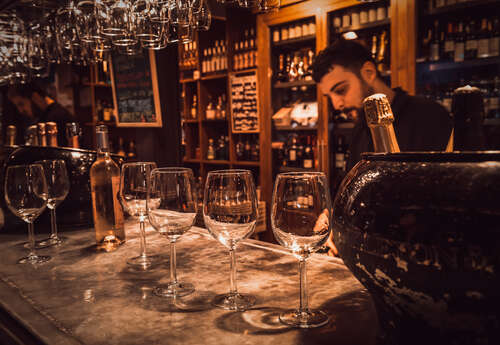
For years now, many wine writers and winemakers in the Old World, and even some in the New, have blamed the existence of excessively ripe, oaky, alcoholic wines squarely on American wine drinkers. Just look at the justifications given by the Italian wine press for Montalcino’s infamous 2008 grape-blending scandal, “Brunellogate.”
In a rare show of unity, Italian wine blogs, websites, and even mainstream newspapers covering the scandal surmised that any alleged blending of Sangiovese with other grapes such as Merlot was done to soften the wine and make it easier for “inexperienced American palates.” Critics continue to point to the US market as the raison d’être for this more muscular and obvious style. In his column in the May 2012 issue of Decanter, Hugh Johnson delightfully describes these concentrated, tannic wines as “wrist sprainers” that are “offered to us in their thickly-muffled youth, coffeed up with oak, their dense flavors, sweetness, tannins, and alcohol clogging up our palates.” He adds, “I know it’s the style favored in the US.”
No one disputes that the trend for these bombastic wines, which had firmly taken hold by the early 1990s, was started by a handful of American wine critics who unabashedly gushed over them; or that for years many, if not most, American wine drinkers, most of them new to the culture of wine, welcomed these high-scoring, pumped-up parodies of wine. It is also true that winemakers around the world raced to please these untried palates by embracing new practices, such as excessively low yields and extended hang-times to increase alcohol, concentration, and flavor, to say nothing of concentrators and new oak. French barriques became the symbol of this new school of winemaking even in Italy, where many producers, sick of being seen as inferior to their French and American counterparts, threw out their own traditions and ripped up their indigenous grapes to plant international varieties.
Yet what started as a distinctly American preference for tightly packed wines with searing alcohol and dominant wood sensations soon spread to other parts of the world, Old and New, and today the “American palate” phenomenon is by no means confined to the United States. Although a number of European wine critics profess to despise this “bigger-is-better” style and lament the disturbing sameness among wines from around the globe, a number of these same critics often favor these bombastic wines in blind tastings-a point that Australian wine expert Max Allen drove home in the November 2011 issue of Decanter. Reviewing the results of the magazine’s panel tasting of Australian Shiraz, he writes, “So much for the cool-climate Aussie Shiraz revolution… news of the uprising doesn’t seem to have spread to the northern hemisphere yet,” and “despite tasters’ claims to the contrary, over there you guys are still really digging the big, black, powerful, oaky, warm-climate styles… and the extra ripeness and raisined fruit flavors.” Allen also laments that many of the wines he would love to drink received only two or three stars.
Drinkability the new priority
No one can blame winemakers who covet high scores for making concentrated, muscular wines dominated by oak-driven flavors of espresso and vanilla that obliterate more elegant and restrained wines during blind tastings; the latter generally score poorly under such demanding conditions. Italian winemakers in general have long been among those most anxious to please the critics by producing rich, structured wines, often by forcing down the natural acidity of their indigenous varieties and over-ripening grapes to increase alcohol. Given the great popularity of Italian wine in the USA, the strategy seemed to work-until recently, thanks to the evolution in consumer tastes. And while there may always be consumers who prefer the louder style-including a number of wine drinkers who sip wine as a cocktail before or after meals- more and more Americans, especially those who now pair wine with food, are rejecting these high-scoring, garish wines, finding that they are not easy to drink and even harder to enjoy.
Drinkability is an absolutely essential quality for Neal Rosenthal, iconic wine importer and author of Reflections of a Wine Merchant. Rosenthal, who has been importing classically crafted, terroir-driven wines from France and Italy into the USA since 1977, feels that the trend away from excessive alcohol and concentration, in favor of more authentic, graceful wines-a trend that he thinks has been gathering speed over the past half dozen years-is the result of American wine lovers’ new-found desire simply to enjoy wine. “No one can continue to consume for any length of time wines that are ‘cartoons’; that is, wines that in their exaggerated form are exhausting to drink.
After all, wine is at its best when married to cuisine. Wines that are balanced, complex, and subtle will, at the end of the day, always be appreciated.” Rosenthal, who feels that the stereotype of the American palate is a gross exaggeration, points out that the appreciation for balanced and complex wines is really a return to the past rather than a new trend. “When I first broke into the wine trade in the 1970s, the market for fine wine in the States was defined almost entirely by classical wines from western Europe. It was years later, when the market expanded rapidly and the influence of the media became more important, that the ‘taste’ of the American market could be characterized as one more attuned to higher alcohol, higher extract, more heavily oaked wines,” he explains.
Great Italian wine nothing new
Rosenthal’s description of the Amercian fine-wine scene in the 1970s touches on another fact that many Italian winemakers would prefer to avoid altogether: that some producers made good, even great, wines in Italy long before the mid-1980s, before excessive concentration and evident oak became the new but treacherous touchstones of quality. In what appears to be an attempt to rewrite history, many of today’s top Italian companies, especially those backed up by PR agencies and consulting enologists, like to suggest that before the quality revolution swept down the peninsula-often obliterating both indigenous grapes and local winemaking traditions-Italian wines were harsh and rustic, and those that could age needed decades to come around.
There is a grain of truth in this oversimplification. Were great wines the exception in Italy before the late 1980s? Of course they were-but at that time, quality wines were the exception throughout the world, including France. Did the great Italian wines of yore need many years to soften their aggressive tannins and nervous acidity? Undoubtedly. But this does not in the least diminish the greatness of the many older Italian wines I have tasted and written about over the past decade: the magnificent and complex 1964 and 1971 Barolos from Bartolo Mascarello; the 1961 Barolo and 1971 Riserva Bricco Boschis Vigna San Giuseppe from Cavallotto; Biondi Santi’s Brunello Riservas from 1945, 1955, 1964, and 1975; Lisini’s 1971 and 1975 Brunello Riservas; Gaja’s 1961 and 1964 Barbarescos; and Mastroberardino’s 1934 Taurasi, to name only a few of the most remarkable.
Despite such impressive bottles, most of today’s top Italian firms prefer historical revisionism, refusing to admit that before the quality revolution a small number of established wineries made extraordinary wines. These same companies like to insist that great wines are a new phenomenon in Italy, a result of cutting-edge technology and new wood, which allow the production of wines suitable for “international palates.” The message is clear. All those great, classically-styled Barolos, Barbarescos, and Brunellos would not and could not be appreciated by New World consumers -in particular Coca-Cola-loving Americans, whose taste buds have been dumbed down by a high-fat diet steeped in high-fructose corn syrup, and who crave flamboyant wines muffled in sweetness and coffee sensations imparted by toasted oak.
Evolution in taste
This crass stereotype of the American palate is an almost understandable assumption, given that Italy’s quality revolution was, for the most part, fueled by American critics who knew little about the country’s noble wines but who were suddenly mightily impressed by those Italian bottlings that resembled Cabernet and Merlot from the Napa Valley. A number of critics from around the world followed suit, including Italian wine writers and wine guides that began not only to favor this style, but also to penalize classically crafted wines. In no time, in the perennial quest for top scores, a shocking number of winemakers across Italy ripped up their indigenous vines to plant Cabernet, Merlot, and Chardonnay, and traded their botti (large casks of Slavonian oak) for barriques. The term “traditional” turned into an insult; elegance and complexity were replaced by concentration, and bottle evolution gave way to instant-gratification wines. For decades, many American consumers, and later those around the world, could not get enough of these “modern” Italian wines. Fortunately, the palates of many of these same consumers have evolved, and they are now seeking refinement rather than raw power, while a new generation is shunning their parents’ buttery Chardonnays and woody Cabernets, preferring to experiment with more distinctive wines.
Of course we should be ready to recognize that Italy’s winemaking revolution played a crucial role in cleaning up the country’s once-stagnant wine scene and helped set the stage for its present-day success. “Here in the Langhe, even up until the 1980s, botti were generally filthy and often rotting, having been passed down from father to son for generations, and using water to clean the wine cellar wasn’t just unheard of, it was almost sacrilegious,” says Barolo producer Mauro Veglio. A reformed modernist who has now pulled back on new oak and shuns intrusive cellar techniques, Veglio points out that “the generation of winemakers that broke with local traditions in the 1980s did more than introduce barriques, they also introduced cellar hygiene to the area.” Veglio admits, however, that many of these same producers took things too far. “At one point, there was an over-reliance on new wood, which proved too much for Barolo.” To make more terroir-driven Barolos, Veglio now forgoes selected yeasts for fermentation and carries out the malolactic fermentation in steel rather than in barrique, in order to reduce wood sensations. Although he still ages exclusively in barriques, these days they are only lightly toasted, and only about half are new. The result: graceful Barolos with rich fruit and an unmistakable Nebbiolo character.
Veglio is one of many Italian producers pulling back, presumably in response to the shift in tastes among wine lovers, and especially those in the USA, Barolo’s largest export market. Neil Empson, one of America’s leading Italian wine importers, with offices in Milan and in Washington, agrees that there is a very real shift in American wine preferences across the board. “I believe it’s part of a general evolution in American tastes. The days of over-saucy food and over-oaky Merlot are starting to fade, and Americans are discovering that more restrained, finesse-driven wines are best paired with food. Americans are coming to realize that fine wines don’t necessarily have to blow you over by force of oaked fruit and alcohol, or pack the most impact in a blind tasting. Big, oaky wines are the JR Ewings of the wine world; they belong to a richer, more arrogant, self-assured era that is eons away from today.”
More classically crafted
This switch back to more classically crafted wines has actually been happening in Italy for several years now, but for many of the country’s greatest wines, like Barolo and Brunello, which have some of the longest mandatory aging requirements in the wine world, the move toward elegance, freshness, and purity is being seen only in the latest releases. My recent tasting (in late March 2012) of the 2007 Brunellos, the current release, confirms a widespread shift toward elegance and vibrancy, and away from new oak and extraction. But of course there are still some Brunello producers, albeit an ever-shrinking minority, who still adhere to the school of overripe, overoaked, and overextracted, in what are obvious attempts to cater to what have become the passé palates of certain critics who continue to celebrate high-octane wines.
Although the return to more traditionally crafted wines is taking place across Italy, the situation is far from uniform, and for purists seeking wines that aren’t strangled by new oak, the battle is not yet won. The 2008 Barolos and 2009 Barbarescos-the latest releases showcased at the Nebbiolo Prima press tasting in May 2012-demonstrated a mixed bag of winemaking styles. Because so many Barolo producers have been claiming over the past few years to use fewer new barriques for Piedmont’s flagship wine, I was surprised and more than a little disappointed by the number of 2008 Barolos still reeking of espresso, vanilla, and sawdust, and marred by bitter wood tannins that muffled Nebbiolo’s floral aromas and bright cherry, mineral flavors. It should be noted, however, that the number of overoaked wines (an astonishing number of which hailed from the village of Barolo itself), while still too high for my tastes, was down compared to even three or four years ago.
The 2009 Barbarescos on the whole demonstrated more restraint with oak (with the glaring exception of far too many Barbarescos from Neive that have been molested by new wood). One producer showing a more judicious use of oak in the latest vintages is Ceretto. With the exception of a few excellent older bottlings from 1985 and 1990, I had always found Ceretto’s Barolos and Barbarescos to be too flashy, too oaky, and too extracted for my tastes, so I was surprised by the graceful, pure Nebbiolo aromas and elegant palate of its 2008 Barbaresco Asij and 2009 Barbaresco Bricco Asili Bernadot, both tasted recently. These more supple Barbarescos, unfettered by obvious oak, were all the more interesting because as recently as 2006, Alessandro Ceretto told me that although he had started pulling back on new oak, he had no intention of abandoning any of his 300-liter barriques and returning to the traditional botti grandi.
But that was then, this is now, he explains today. “When I began working at the winery in the second half of the 1990s, it was all about concentration and new oak, not just in Piedmont, but everywhere,” says Ceretto, adding that even though he feels this still seems to be the dominant style in many areas of the world, his own palate has evolved, as has his confidence in his winemaking skills. “Now that I’m 35, I want to make wines that express terroir, that taste like they could only be from here.” To create such wines, in 2008 Ceretto decided to eliminate those winemaking methods that influence taste, such as commercial yeasts and dominant new oak. He now ferments using indigenous yeasts and ages his red wines for half their mandatory aging period in new and used 300-liter barriques, and half in large French casks of up to 25hl. “My philosophy has definitely changed. Now I think that using 100 percent new oak barriques is like buying a cut of fresh, excellent quality fish, and then dousing it in sauce. I can say this because here in Barolo and Barbaresco we have great terroir, but winemakers who don’t are forced to rely on invasive winemaking practices.”
Massolino is another Barolo producer to have pulled back. Best known for its celebrated single-vineyard Barolo Riserva Vigna Rionda, Massolino always employed more classical winemaking methods for its Barolos, such as fermenting in glass-lined concrete tanks, but the estate’s Barolo Parafada, first released in 1990, was aged in barriques until 2006. “We decided then that all of our Barolos should be made in a classic style. To that end, starting in 2006, we began aging Parafada in 40hl casks, like our other Barolos. When I started in 1990, I wanted to experiment with barriques, but now I want to make a wine that I like, and not simply what the market likes,” explains Franco Massolino.
Producers in other parts of Italy are also hanging up their barriques, and many are breaking away from their consulting enologists, including Campania’s Feudi di San Gregorio, a former poster child for the dense, sweet, and oaky wines that seemed to express the hand of their former enologist Riccardo Cotarella rather than Campania’s unique growing conditions and native grapes. After the jet-setting Cotarella and Feudi parted ways in 2007 after a decade of collaboration, Antonio Capaldo, who took over the family firm four years ago, began focusing on the vineyards with full-time agronomist Pierpaolo Sirch, rather than relying on intrusive cellar practices. Capaldo has also turned the winemaking over to a dedicated in-house staff, but consults occasionally with Alto Adige’s award-winning enologist Hanz Terzer from San Michele d’Appiano for guidance on his white wines.
Feudi’s revamped whites aptly demonstrate the firm’s new approach. With no more barrique aging, and now allowed to flaunt their vibrant natural acidity, Feudi di San Gregorio’s Fiano, Falanghina, and Greco di Tufo are fresh and crisp, boasting pure fruit flavors and mineral notes-a far cry from the rich and structured style of the Napa Chardonnays they once seemed to emulate. “We made the change not only because we feel that the market is turning in that direction, but because we want all our wines to reflect Campania and its own grapes, not international wines from anywhere,” says Capaldo. While he says that the market has been very receptive so far, he admits that some may be resistant and hard to win round: “My trips to America reveal that many consumers who can afford to buy expensive bottles still want the oak and heft, and feel cheated if a pricey wine lacks these sensations.”
Cause and cure
While many argue over the continued existence of the “American palate” and all its stereotypes, no one can deny the growing interest in the USA, and around the world, in more drinkable and terroir-driven wines. And while it may be argued that the now-global taste for the heavy-handed style was a late-20th-century US export, and that it may even have caused nearly as much damage to the world’s fine-wine industry as did the unintentional US export of phylloxera in the latter half of the 19th century, then once again, perhaps, the cure may come from the same shores. Just as American rootstocks stopped the ravages of phylloxera, so the growing number of American wine lovers who are following their own palates may convince even more winemakers in Italy and elsewhere to return to more classically crafted wines.






